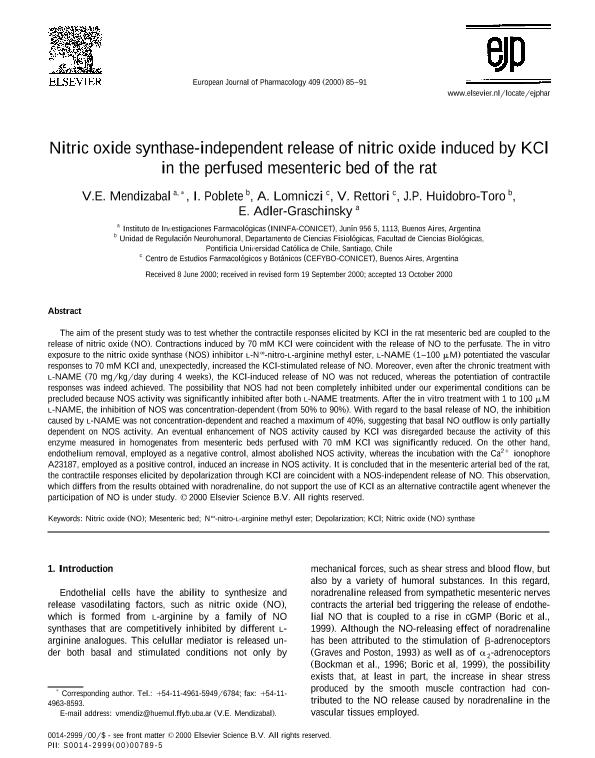Mostrar el registro sencillo del ítem
dc.contributor.author
Mendizabal, Victoria Eugenia

dc.contributor.author
Poblete, I.
dc.contributor.author
Lomniczi, A.
dc.contributor.author
Besuhli, Valeria

dc.contributor.author
Huidobro Toro, J. P.
dc.contributor.author
Adler, Edda

dc.date.available
2018-03-16T23:49:52Z
dc.date.issued
2000-12
dc.identifier.citation
Mendizabal, Victoria Eugenia; Poblete, I.; Lomniczi, A.; Besuhli, Valeria; Huidobro Toro, J. P.; et al.; Nitric oxide synthase-independent release of nitric oxide induced by KCl in the perfused mesenteric bed of the rat; Elsevier Science; European Journal of Pharmacology; 409; 1; 12-2000; 85-91
dc.identifier.issn
0014-2999
dc.identifier.uri
http://hdl.handle.net/11336/39157
dc.description.abstract
The aim of the present study was to test whether the contractile responses elicited by KCl in the rat mesenteric bed are coupled to the release of nitric oxide (NO). Contractions induced by 70 mM KCl were coincident with the release of NO to the perfusate. The in vitro exposure to the nitric oxide synthase (NOS) inhibitor L-N(ω)-nitro-L-arginine methyl ester, L-NAME (1-100 μM) potentiated the vascular responses to 70 mM KCl and, unexpectedly, increased the KCl-stimulated release of NO. Moreover, even after the chronic treatment with L-NAME (70 mg/kg/day during 4 weeks), the KCl-induced release of NO was not reduced, whereas the potentiation of contractile responses was indeed achieved. The possibility that NOS had not been completely inhibited under our experimental conditions can be precluded because NOS activity was significantly inhibited after both L-NAME treatments. After the in vitro treatment with 1 to 100 μM L-NAME, the inhibition of NOS was concentration-dependent (from 50% to 90%). With regard to the basal release of NO, the inhibition caused by L-NAME was not concentration-dependent and reached a maximum of 40%, suggesting that basal NO outflow is only partially dependent on NOS activity. An eventual enhancement of NOS activity caused by KCl was disregarded because the activity of this enzyme measured in homogenates from mesenteric beds perfused with 70 mM KCl was significantly reduced. On the other hand, endothelium removal, employed as a negative control, almost abolished NOS activity, whereas the incubation with the Ca2+ ionophore A23187, employed as a positive control, induced an increase in NOS activity. It is concluded that in the mesenteric arterial bed of the rat, the contractile responses elicited by depolarization through KCl are coincident with a NOS-independent release of NO. This observation, which differs from the results obtained with noradrenaline, do not support the use of KCl as an alternative contractile agent whenever the participation of NO is under study. (C) 2000 Elsevier Science B.V.
dc.format
application/pdf
dc.language.iso
eng
dc.publisher
Elsevier Science

dc.rights
info:eu-repo/semantics/openAccess
dc.rights.uri
https://creativecommons.org/licenses/by-nc-sa/2.5/ar/
dc.subject
Depolarization
dc.subject
Kcl
dc.subject
Mesenteric Bed
dc.subject
N(Ω)-Nitro-L-Arginine Methyl Ester
dc.subject
Nitric Oxide (No)
dc.subject
Nitric Oxide (No) Synthase
dc.title
Nitric oxide synthase-independent release of nitric oxide induced by KCl in the perfused mesenteric bed of the rat
dc.type
info:eu-repo/semantics/article
dc.type
info:ar-repo/semantics/artículo
dc.type
info:eu-repo/semantics/publishedVersion
dc.date.updated
2018-03-16T15:14:26Z
dc.journal.volume
409
dc.journal.number
1
dc.journal.pagination
85-91
dc.journal.pais
Países Bajos

dc.journal.ciudad
Amsterdam
dc.description.fil
Fil: Mendizabal, Victoria Eugenia. Consejo Nacional de Investigaciones Científicas y Técnicas. Oficina de Coordinación Administrativa Houssay. Instituto de Investigaciones Farmacológicas. Universidad de Buenos Aires. Facultad de Farmacia y Bioquímica. Instituto de Investigaciones Farmacológicas; Argentina
dc.description.fil
Fil: Poblete, I.. Pontificia Universidad Católica de Chile; Chile
dc.description.fil
Fil: Lomniczi, A.. Consejo Nacional de Investigaciones Científicas y Técnicas. Oficina de Coordinación Administrativa Houssay. Centro de Estudios Farmacológicos y Botánicos. Universidad de Buenos Aires. Facultad de Medicina. Centro de Estudios Farmacológicos y Botánicos; Argentina
dc.description.fil
Fil: Besuhli, Valeria. Consejo Nacional de Investigaciones Científicas y Técnicas. Oficina de Coordinación Administrativa Houssay. Centro de Estudios Farmacológicos y Botánicos. Universidad de Buenos Aires. Facultad de Medicina. Centro de Estudios Farmacológicos y Botánicos; Argentina
dc.description.fil
Fil: Huidobro Toro, J. P.. Pontificia Universidad Católica de Chile; Chile
dc.description.fil
Fil: Adler, Edda. Consejo Nacional de Investigaciones Científicas y Técnicas. Oficina de Coordinación Administrativa Houssay. Instituto de Investigaciones Farmacológicas. Universidad de Buenos Aires. Facultad de Farmacia y Bioquímica. Instituto de Investigaciones Farmacológicas; Argentina
dc.journal.title
European Journal of Pharmacology

dc.relation.alternativeid
info:eu-repo/semantics/altIdentifier/doi/http://dx.doi.org/10.1016/S0014-2999(00)00789-5
dc.relation.alternativeid
info:eu-repo/semantics/altIdentifier/url/https://www.sciencedirect.com/science/article/pii/S0014299900007895
Archivos asociados
